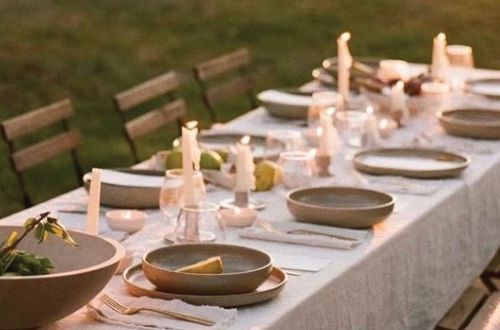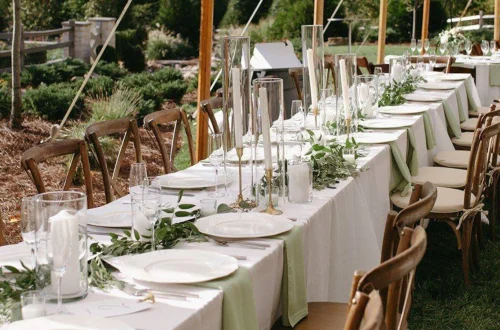Arguing that the most memorable events appeal to all five senses, music and scent are the often-overlooked secret weapons of great hosts. While visual elements like decorations and tablesettings capture immediate attention, sound and scent work on a subconscious level to create lasting emotional impressions. These invisible elements have the power to transport guests, evoke memories, and establish the perfect atmosphere for your gathering. This comprehensive guide will explore how to thoughtfully incorporate music and scent into your event planning, transforming a simple gathering into a truly immersive experience. Understanding the psychology behind these sensory elements ensures your event resonates with guests long after they’ve gone home, creating the kind of memorable experience that’s worth sharing and repeating.
Part 1: The Power of the Playlist
Music serves as the invisible thread that weaves through your entire event, influencing mood, pace, and even how guests interact with each other and your space.
The Arc of the Party:
Create different playlists for different phases of your event to guide the experience and energy level:
- Welcome Music (Arrival): Play welcoming, upbeat but not overwhelming music as guests arrive. This helps people feel comfortable and start conversations while they wait for others to arrive.
- Mingling Music: As more guests arrive and begin to move around, transition to music that encourages conversation but maintains energy. Choose songs that aren’t too loud or too distracting.
- Dinner Music: During the main meal, select softer, more ambient music that enhances the dining experience without competing with conversation.
- Dessert/Cocktail Music: As the meal ends, gradually increase energy to encourage continued socializing and transition to post-dinner activities.
- Evening Farewell: Wind down with music that’s slightly more reflective as guests begin to depart, leaving them with pleasant memories.
Volume Guidelines: Keep music at a level where guests can easily hear each other and maintain conversation. A good rule is that music should fill silence but not dominate speech. Test your volume levels during setup to ensure proper balance.
Creating the Right Energy:
Consider your audience and the type of gathering when selecting your music. A sophisticated dinner party might feature jazz or classical music, while a casual birthday party might benefit from upbeat pop music that encourages dancing and celebration.
Pay attention to the cultural backgrounds of your guests and avoid music that might make anyone uncomfortable or exclude them from the experience.
Part 2: The Psychology of Scent
Our sense of smell is directly connected to the limbic system, the part of the brain responsible for emotions and memory formation, making scent an incredibly powerful tool for creating lasting impressions.
First Impressions:
The aroma that greets guests as they enter your home sets the immediate tone for their entire experience. A welcoming scent right at the entryway – like a subtle diffuser or fresh flowers – creates an immediate positive tone that enhances their overall perception of your event.
Consider the psychological associations of different scents: vanilla and cinnamon evoke comfort and home, while citrus scents provide energy and cleanliness. Lavender and eucalyptus create relaxation and sophistication.
Complementing the Food:
Choose scents that complement rather than compete with your food. For dinner parties, fresh and herbal scents like rosemary or citrus work better than overly sweet or floral ones that might interfere with the aroma of your cooking.
Consider how your scent will interact with the foods you’re serving. A rich, heavy scent might compete with delicate flavors, while a light, clean scent can enhance the dining experience.
Sensitivity Considerations: Always consider that some guests may have scent sensitivities or allergies. Choose mild, natural scents and avoid anything too strong that might overwhelm or cause discomfort.
Part 3: Practical Scenting Ideas
There are numerous ways to incorporate scent into your event in a natural, appealing way that enhances rather than dominates the experience.
Natural Scent Sources:
- Simmering Pot: Create a pot of simmering water with cinnamon sticks, orange peels, and cloves on your stove. This provides natural, warm scenting that also adds to the homey atmosphere.
- Fresh Eucalyptus: Place fresh eucalyptus on tables or in bathrooms. It provides a clean, refreshing scent without being overwhelming.
- Fresh Baked Goods: The aroma of freshly baked cookies, bread, or other items provides natural, welcoming scenting that also creates anticipation for your event.
- Potted Herbs: Use rosemary, basil, or mint as both decoration and natural scenting elements that also add to your table aesthetic.
Candles & Diffusers:
- High-Quality Candles: Use premium unscented or subtly scented candles in living areas. Choose scents that are appropriate for the season and occasion.
- Reed Diffusers: These provide consistent, gentle scenting for longer events without requiring constant attention.
- Essential Oil Diffusers: These create gentle, adjustable scenting while providing the benefit of aromatherapy.
Dining-Specific Considerations:
Always use unscented candles on the dining table itself to avoid competing with food aromas. If you want scenting in the dining area, place scented elements in adjacent areas or use very subtle diffusers that won’t interfere with the food experience.
Coordinating Music and Scent with Themes
Aligning your music and scent choices with your event theme creates a cohesive, immersive experience that feels intentional and well-planned.
Themed Coordination:
For a rustic event, consider folk music paired with the scent of fresh wood or pine. For a sophisticated dinner party, smooth jazz with subtle vanilla or sandalwood scents creates an elegant atmosphere.
Seasonal events benefit from coordinated music and scents that reinforce the seasonal theme. Summer events might feature tropical music with citrus or ocean scents, while winter gatherings work well with holiday music and warm spice scents.
Pre-Event Testing: Test your music and scent combinations in your space before the event to ensure they work well together and don’t clash. Consider how different lighting conditions might affect the perception of both elements.
Technical Considerations for Audio Setup
Proper audio setup ensures your music creates the desired effect without technical issues or inconsistent coverage.
Speaker Placement:
Position speakers strategically to provide even coverage throughout your entertaining areas. Avoid placing speakers too close to seating areas where they might be too loud, but ensure quiet spots don’t exist where conversation becomes difficult.
Consider the acoustics of your space – hard surfaces reflect sound while soft surfaces (cushions, curtains) absorb it. Adjust your setup accordingly to achieve balanced sound.
Music Sources and Backup Plans:
- Streaming Services: Use reliable streaming services with pre-made playlists or create your own curated selections.
- Backup Devices: Have a secondary music source available in case your primary device fails.
- Volume Control: Ensure you have easy access to volume controls to make adjustments as needed throughout the event.
- Song Selection: Create playlists in advance to avoid the temptation of pausing to change music during the event.
Seasonal Adaptations
Adjusting your music and scent choices based on the season and specific occasion helps create a more immersive, appropriate experience.
Seasonal Music Selection:
Spring events might benefit from fresh, light music that reflects renewal and growth. Summer gatherings often work well with upbeat, tropical, or outdoor-friendly music that matches the energy of longer days.
Fall events can incorporate slightly more mellow tones that complement the cozy feeling of the season, while winter events might feature warm, intimate music that encourages gathering together.
Seasonal Scenting:
- Spring: Light floral scents, fresh green notes, or the scent of rain on earth
- Summer: Citrus, ocean scents, or light herb aromas
- Fall: Warm spices, wood scents, or the aroma of baking
- Winter: Vanilla, cinnamon, or pine scents that create warmth
Troubleshooting Common Issues
Understanding potential problems with music and scent implementation helps ensure your event proceeds smoothly.
Music Problems:
Feedback and Technical Issues: Test all equipment before guests arrive and have backup options available. Ensure all devices are charged and connected properly.
Guest Preferences: Some guests may have strong opinions about music. Keep the volume moderate and choose universally appealing selections to minimize potential disagreements.
Scent Issues:
Overpowering Scents: Start with light scenting and gradually increase if needed. It’s easier to add more scent than to eliminate an overwhelming one.
Sensitivity Reactions: Be prepared to remove or neutralize scented elements if guests show signs of discomfort.
Scent Safety: Never leave candles unattended and ensure proper ventilation. Some guests may have scent sensitivities, so always have options to remove or reduce scents if necessary.
Conclusion
Summarizing that thoughtfully incorporating music and scent are subtle, sophisticated ways to transform a simple gathering into a truly immersive experience, these elements work together to create lasting memories that guests will associate with your hospitality.
The key to success with these sensory elements is subtlety and thoughtfulness. Neither music nor scent should overwhelm the space or compete with conversation. Instead, they should enhance the experience, making guests feel welcomed, comfortable, and engaged.
Remember that these elements require planning and testing to achieve the desired effect. What seems perfect in an empty room might feel too strong or too weak with guests present and other sounds and smells competing for attention.
By paying attention to these often-overlooked sensory details, you elevate your hosting from simply providing food and drink to creating a complete, memorable experience that demonstrates attention to detail and thoughtful planning.
The investment in creating the right audio and olfactory environment pays off in the form of positive guest experiences and events that are remembered fondly long after they’ve ended.





